Vanilla Sky
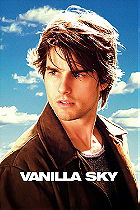 Posted : 11 years, 4 months ago on 9 February 2014 01:51
(A review of Vanilla Sky)
Posted : 11 years, 4 months ago on 9 February 2014 01:51
(A review of Vanilla Sky)Based on Abre Los Ojos, Vanilla Sky practically deconstructs the “Tom Cruise” image and affords him a chance to give a truly original performance. He meets the task with great aplomb, which truly surprised me. I have long regarded Cruise as a movie star, granted he’s a great one, but a limited actor, frequently given to scowling and looking intense in place of creating a real character. There have been some exceptions: I adore Legend, I think his work in Interview with the Vampire is great, and he’s never been better than he was in Born on the Fourth of July. So I didn’t walk into with Vanilla Sky with a lot of expectations about what was in store.
Color me happily surprised when what emerged was a film in which Cruise plays a playboy with more money, fame and toys than God, and these don’t even begin to satiate his need to consume and conquer more. After an accident disfigures his face, this God-like rich boy is brought down to the mortal plane and forced to face the ways in which he discarded and used people. It is once he awakens from this turmoil and tries to pick his life back up that unexplainable events begin to happen. Did he have something to do with a former lover’s death? Is he truly the master/author of his life, or is someone else pulling the strings behind the scenes?
I can’t begin to summarize the plot in a limited space, nor all of the twists that it takes on, but I will say that it ends up going to daringly obscure places that I didn’t think it would when it began. But the heavy symbolism did strike me as odd. This rich, spoiled man truly found his life recreating album covers and scenes from movies? How saturated colors are in various scenes, in retrospect, seem to answer these questions. And while Crowe is clearing going for a level of David Lynch-like weirdness, he, unlike Lynch, actually feels like he needs to answer every question and explain every strange twist and turn. I believe if some of it was left up to our imaginations that Vanilla Sky would have emerged a better film.
But Crowe was smart enough to think outside-of-the-box and ensemble a strange cast of actors who we wouldn’t immediately think of for these roles. I’ve already mentioned Cruise who begins the film as the movie star we think he is, and ends up a paranoid man who has dismantled that perception with several small choices that are very smart. Supporting him as the two romantic leads are Cameron Diaz and Penelope Cruz, carried over from the Spanish original. At this time Cruz was relatively unknown in to American moviegoers, and her sexy, quiet work here is quite lovely. She manages to deliver some very oddball lines with sincerity and depth, I’m thinking of the one where she tells him that they’ll meet in their next life as cats. This more sane, rational character stands in stark contrast to more obsessive and unstable ones she’s famous for (Vicky Christina Barcelona, Nine).
But the true acting revelation amongst the supporting players is Diaz, getting in touch with her inner Fatal Attraction and creating a sympathetic, deranged yet poignant character in the end. She’s sexy, vivacious, neurotic and dangerous with equal measure, making each twist and turn believable and it made me wonder why she delivers a truly great performance only once every few years. Other supporting roles are taken up by actors who are always interesting in any project that they do. Kurt Russell, Noah Taylor, Timothy Spall, Tilda Swinton, Alicia Witt, Michael Shannon all create a unique cacophony of voices that work in tandem with the general strangeness of the film as a whole.
You’ll notice that throughout I have mentioned that Vanilla Sky is odd, and described it with a variety of synonyms. Perhaps the best word for it is: hallucinatory. Or maybe love-it-or-hate-it could work even better. It doesn’t matter to me which camp you fall into, because I think we can agree on one thing as we discuss a film like this. It’s hard to shake the overall impression and numerous images long after you have watched it. And I think that for that reason alone, Vanilla Sky is worthy of a recommendation and a mention as something truly special. However you take the word special though, is entirely up to you, since we all know which category I have fallen in.
 0 comments, Reply to this entry
0 comments, Reply to this entry
The Turning Point
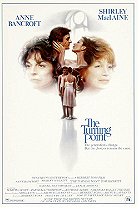 Posted : 11 years, 4 months ago on 3 February 2014 10:49
(A review of The Turning Point)
Posted : 11 years, 4 months ago on 3 February 2014 10:49
(A review of The Turning Point)Eleven Academy Award nominations.
This was all that kept running through my mind when I was watching The Turning Point, a thin film that somehow ended up with a lion’s share of nominations at that year’s Oscar telecast. That many nominations on a film this generically plotted, anemically directed and indifferently acted by most of the supporting cast found itself sailing in the Oscars in 1977 with the most nominations out of any other film that year. That it got shut out is no big surprise. Maybe the voters just got confused that a film about the world of ballet was intrinsically high-art worth celebrating because it was about a high-art worth celebrating?
No matter. All those nominations have done, fairly or unfairly, has saddled us with a preconceived notion that this is a film worth celebrating and remembering for some kind of high artistic achievement. Like it or not, an Oscar nomination (and moreso a win) is typically a barometer of some kind of high-level of success in the industry. The Turning Point is Lifetime movie material decades before the very idea of that type of movie-making even came into our pop culture vocabulary.
It tells the story of two former friends and ballet dancers, one who left the life to start a family (Shirley MacLaine) and the other who stayed and became a huge star (Anne Bancroft). MacLaine’s oldest daughter shows great promise as a dancer and Bancroft takes her under her tutelage and introduces her to the world of professional dance. This sets in motion the story beats for their decades-long cold war to explode in a climatic cat-fight. Meanwhile, MacLaine’s daughter (Leslie Browne, inexplicably Oscar nominated) meets a sexy, brooding, womanizing bad boy dancer (Mikhail Baryshnikov, also Oscar nominated but he showed more promise as an actor). That’s the entirety of the sub-plot – good girl meets bad boy, romantic entanglements ensue, happy ending for the couple.
Amidst all of the too-tasteful-for-its-own-good film-making, Turning Point at least it offers MacLaine and Bancroft the offer to act their asses off, and they sink into these roles for everything that they’re worth. Sometimes the film does indulge in the worst of diva-centric tendencies, but at least when these two are sparring they’re immensely watchable and entertaining.
The other incredibly commendable aspect of the film is the extended sequences of actual ballet dancers doing what they do best. Not since The Red Shoes has a film about a ballerina showcased such lovely and extended dance sequences. But unlike Red Shoes, this film doesn’t have the imagination or creativity to do anything other than point-and-shoot the sequences. So all of the beauty and awe in the dance numbers come from watching trained professionals at the high of their talents do what they love, the costumes and sets.
It’s such a pity that The Turning Point turned out so boring. There’s clearly a better movie to be made out of ballet. Black Swan and The Red Shoes come to mind as films set within the world that do something better to explore it and place us in the minds/bodies of the dancers. Turning Point is pure sappy melodrama from start-to-finish with terrible dialog, wooden acting from Browne and several other supporting actors, and a cliché ridden script that sign-posts its motivations and plot twists thirty minutes in advance with no subtly or complications. To put it more distinctly, it’s boring outside of the two lead performances and watching talented ballet dancers twist and contort.
 0 comments, Reply to this entry
0 comments, Reply to this entry
Midnight Cowboy
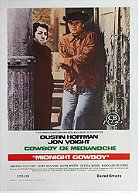 Posted : 11 years, 4 months ago on 3 February 2014 10:49
(A review of Midnight Cowboy)
Posted : 11 years, 4 months ago on 3 February 2014 10:49
(A review of Midnight Cowboy)As a portrait of two lost and hurt souls reaching through the urban decay and finding companionship with each other, Midnight Cowboy soars high. The problem is that the comedown from the swinging sixties causes us to insert needless dives into Warhol’s Factory and other flashy moments which distract from the grimy and gloomy study of these two men beautifully played by Dustin Hoffman and Jon Voight.
Katharine Hepburn has famously stated that the right actors win Oscars for the wrong roles, and no actor better exemplifies that quote then Dustin Hoffman. Kramer vs Kramer and Rain Man don’t exactly spring immediately to mind when I think of his most award-worthy and iconic work, The Graduate and Cowboy are. His Ratso is one of the greatest performances of all-time for me. Hoffman disappears and in his place is only this sickly, hard-edged street operator. It’s one hell of a performance as Hoffman descends into more desperation and by the end looks like walking pestilence and death.
And Voight meets him halfway. Midnight Cowboy is a two-hander, and if either performance didn’t click into place the entire thing would topple in on itself. And Voight’s dim-witted Texan who comes to New York to be a gigolo is a nice counter-balance to Hoffman’s cynicism. His character is almost like a sweet-natured Labrador dropped into the middle of the seediest kennel you could imagine, and he plays it perfectly. His character develops a cocksure walk and possesses a naïve handsomeness that visually works in synchronicity with Hoffman’s shorter, dirtier and curled up posture. The character’s questionable sexuality – the film seems to want to point towards him being gay, but never really commits is a sin of a script that can’t decide what it wants to do with this thread.
So why doesn’t Midnight Cowboy work entirely effectively? Far too many detours into situations and characters that don’t add anything of deep significance to the main narrative or the bigger theme of the film, and these scenes are too artsy and remove us from the truth of the film and call too much attention to themselves. Would these penniless drifters truly find themselves in a party with Warhol’s superstars? I don’t believe so, and this entire segment could be removed with relative ease and the film would only be the better for it. I also don’t know if I completely believe the film’s climax occurring with them hopping on a bus to Florida and trying to find that happy ending. The world of the film is Times Square when that was a dirty place.
In the end, Midnight Cowboy is the story of two souls struggling valiantly to survive and be a little less lonely. Every time the film swerves away from this basic conceit it ends up hurting it more than anything. But what is great is amongst some of the most ambitious and well-crafted film-making of the 1960s. I truly get why so many call this film essential, but I think many of us have done a mental self-edit of some of the more unnecessary parts of the film. But the central performances/characters are so finely detailed and thoroughly defined that all else almost doesn’t even matter.
 0 comments, Reply to this entry
0 comments, Reply to this entry
True Grit
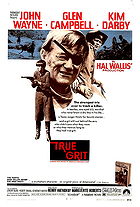 Posted : 11 years, 5 months ago on 13 January 2014 10:23
(A review of True Grit (1969))
Posted : 11 years, 5 months ago on 13 January 2014 10:23
(A review of True Grit (1969))We could sit here all day and argue over and over again whether or not his Oscar for Best Actor was a career achievement-in-disguise or won based on pure merit. It’s not hard to imagine a successful argument being made for his overlooked work in Red River or The Searchers as being more worthy of posterities value of what Wayne’s best performances are, but there’s just something about True Grit and Wayne’s performance that feels right to be the film that finally won him some overdue recognition.
Rooster Cogburn feels like the role that Wayne’s career was always leading him towards, and who else at the time could make this character work so beautifully? It’s not just his image as the Mount Rushmore of Western film-making or iconography as Americana incarnate, but the strange choices that feel so right and give this character a beating heart and inner life. The scene in which Wayne utters the immortal line “Fill your hand, you son of a bitch!” feels like a classic moment in which a great star’s persona and mystique has come to its apotheosis. This is John Wayne, the movie star and actor colliding into one and feels like the passing of a bygone era in which he was king.
It’s just such a shame that the rest of the movie couldn’t match wits with his brilliant star turn. Dennis Hopper and Robert Duvall stand out amongst the supporting players for turning in sinister and idiosyncratic turns. They add color and texture in a symbolic sense in a film that desperately needed some. But it’s a pity to announce that they’re shoved off to the sidelines for much of the film. Hopper only has about one scene and Duvall doesn’t appear until very late in the game. For a majority of the time we’re stuck with Kim Darby and Glenn Campbell.
Charles Portis’ dialog is a stylized creature that requires a deft balance to make it sing. The Coen Brothers made it work marvelously with Hailee Steinfeld and Matt Damon in the other two major roles, which is more than can be said for Henry Hathaway’s work with Darby and Campbell in the same roles. Darby, clearly too old for the role, is far too mannered and struggles with the rhythm of the language fairly often. Campbell doesn’t even appear to be trying to act, and his presence is pure dead weight. These two are large weights bringing the film down.
Of course tighter editing and a better sense of storytelling could help overcome these obstacles, but Hathaway is content to take his sweet time getting from one story point to another. True Grit frequently falls into boring and safe waters, even when the story clearly has something spikier and punchier going on underneath. As a film, it’s a mess. But as a star vehicle, John Wayne’s charisma makes this something indelible and the reason that it has endured.
 0 comments, Reply to this entry
0 comments, Reply to this entry
The Band Wagon
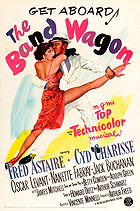 Posted : 11 years, 5 months ago on 13 January 2014 10:23
(A review of The Band Wagon (1953))
Posted : 11 years, 5 months ago on 13 January 2014 10:23
(A review of The Band Wagon (1953))Revisiting The Band Wagon only heightened some of my first and distinct impressions of the overall film. It is a series of glorious, isolated moments that rank among the best of the movie musical and MGM’s already hefty output during this era, but when strung together it does not add up to something truly great. The threadbare plot and hodgepodge ideas feel in search of a deeper function until the next big number comes along. It is all an explosion of color and the athletic, sexy things the human body can do in dance, which is sometimes more than enough.
The Band Wagon concerns a fallen movie star (Fred Astaire), displaced by changing tastes/times, looking for a career rebound and finding it in the ramshackle Broadway show presented to him by his two friends (Oscar Levant and Nanette Fabray as an in-joke Betty Comden and Adolph Green). What follows is a behind-the-scenes glimpse of putting on a show – writing process, assembling the creative talent, out-of-town tryouts, and finally, the big opening night. A persistent tone of wistfulness, if not downright melancholia, pervades over the whole enterprise as the ephemeral nature of “putting on a show” is highlighted again and again and again.
It makes sense that Astaire would take the lead in a film like this as contemporaries like Gene Kelly were too proletariat in comparison. The film needed a star who seemed self-possessed, and Astaire’s commitment to perfectionism was well-known at the time. Co-star Fabray said, “Fred rehearsed until he drove you crazy.” The results show as Astaire’s penchant for being a one-man whirling dervish is only underscored by the likes of “By Myself,” “Shine on Your Shoes,” and nearly stealing the show from his partners in “That’s Entertainment,” where the four performers practically show you their bruised, bloodied, and exhaustively rehearsed bodies and demand for our applause and love. They get them, oh boy do they get them.
Without a comparable leading lady, think the likes of Rita Hayworth, Ginger Rogers, or Judy Garland, Astaire would come across as a strangely sexless, nearly asexual screen presence for a dancer. He was not a generous movie dancer, and he needed a strong partner to shore up his weakness or match his intensity. Cyd Charisse matches him when it comes to dancing but is inert at this point in her acting career. She is only halfway there as a sparring partner for Astaire, but a lot of the blame for that goes to MGM’s insistence on polishing out the native accent and charm of Charisse and making her into another transatlantic bombshell.
Forgiveness for her lack of sexual chemistry and inert acting abilities aside, she is a stellar dance partner for him. “Dancing in the Dark” is a romantic ballet between the two that finds Charisse throwing her body around in ways that merge the transcendent, the euphoric, and the erotic in mystical ways. This was the power of her as a dancer. We see the two of them matching in technical skill and expanding into something more and greater than their individual talents.
Then comes “Girl Hunt Ballet,” a bit of a goof on Gene Kelly’s dream ballets in his films. It is also one of the greatest pieces of musical filmmaking that Minnelli ever created. Charisse and Astaire roll through a staggering number of emotions through their bodily pantomimes, and the only comparable acting equivalent would be the torrent of verbiage that comes from performing Shakespeare. It is a highpoint for all involved with Astaire as film noir antihero, Charisse as the femme fatale, and some of the jazziest choreography I’ve ever seen. Charisse’s reveal of her red tasseled dress is filled with a carnality and grace that makes going to the movies a perfect excuse to watch beautiful people doing interesting things with their bodies.
Although, if you’re anything like me, you will have noticed that the various scenes for the Broadway show make absolutely no sense when strung together. (Yes, even factoring in the revue makeover.) They are merely a body of work that exist independently from each other to entertain us. (Seriously, what the hell is that “Triplets” number? I’ve seen the film twice and still am flabbergasted by it.) The connecting tissue is shambolic, but the final results, the stuff that lingers longest in the mind, is some the purest, best musical ephemera of the decade. That’s entertainment? Yeah, that’s entertainment. (La la la la la la.)
 0 comments, Reply to this entry
0 comments, Reply to this entry
Best Foot Forward
 Posted : 11 years, 5 months ago on 12 January 2014 08:03
(A review of Best Foot Forward)
Posted : 11 years, 5 months ago on 12 January 2014 08:03
(A review of Best Foot Forward)There’s not much to it, but Best Foot Forward owns much of its success to Ball’s knowing performance. She’s in on the jokes, and is unafraid to take a pratfall or look less than glamorous if it’ll get a laugh. These traits would be better explored and given immortality in I Love Lucy, but even here Ball is allowed to look gorgeous, toss of a few zingers, have a klutzy moment and poke fun at her stardom.
And poor Virginia Weidler, a former child star probably best known for her roles in The Philadelphia Story and The Women, is given her chance to bridge the gap between child stardom and adult stardom but never managed to make it. This would be her last film, and it all boils down to being out-shown by a trio of newcomers: June Allyson, Gloria DeHaven and Nancy Walker, who out does them all with her pitch-perfect timing and the three of them have the greatest moment in the film with “The Three B’s.” Best Foot Forward never demanded much from its audience like classics Meet Me in St. Louis or An American in Paris did, but there’s plenty of flimsy charms to hold your interest.
 0 comments, Reply to this entry
0 comments, Reply to this entry
5 Against the House
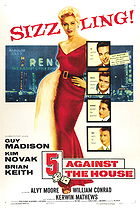 Posted : 11 years, 5 months ago on 12 January 2014 08:03
(A review of 5 Against the House (1955))
Posted : 11 years, 5 months ago on 12 January 2014 08:03
(A review of 5 Against the House (1955))The five of the title refer to a group of college students, some of whom are Korean War veterans, who idly pass the time joking about a plan to steal big from a casino. As one of them begins to emotionally and mentally unravel, the plan turns from a joke into a reality. 5 takes about a third of its time setting up this premise, with a few detours to develop Brian Keith’s veteran and his eventual break from sanity and a romance between Guy Madison and Kim Novak. Novak isn’t given too much to do in the girlfriend role, but she turns in a fine performance.
But the heist is the grand center piece, and it’s pulled off very well. No pun intended by that. Yet it’s after the heist that the film devolves and decides that it needs to quickly wrap it up and rushes to an unsatisfactory conclusion only because it has been given no room to organically and logically grow. Keith’s performance is more than enough of a reason to watch this film, it truly is one hell of a performance when all is said and done, but 5 Against the House has plenty of other minor merits going for it to say that it is enjoyable, but, man, it could have turned out so much better if it had another twenty minutes or so to flesh out that conclusion.
 0 comments, Reply to this entry
0 comments, Reply to this entry
For Whom the Bell Tolls
 Posted : 11 years, 5 months ago on 12 January 2014 08:03
(A review of For Whom the Bell Tolls)
Posted : 11 years, 5 months ago on 12 January 2014 08:03
(A review of For Whom the Bell Tolls)Cooper plays an American with a talent for explosives, weary but yearning to be where the action is, he finds himself in the midst of the Spanish Civil War. Eventually he hooks up with a group of rebels and much of the film is spent weighing the pros and cons of a specific bridge’s destruction and its strategic values. Factor in plenty of romantic interludes between Cooper and Ingrid Bergman, never quite getting a handle on that accent but looking incandescent, a few battle scenes, and loads of debating between the guerilla fighters, and the film’s near three hours presents a challenge.
Editing is key, and a very fine art. Bell Tolls suffers from excessive padding and not knowing what to cut or shorten in an adaptation. It’s not that there’s too much plot to justify this length, but too little and much of it could have been shortened to provide some clarity or a point-of-view. I would have played up the politics and moral quagmires and played down the romance myself, but here they’re given semi-equal weight. The romance wins out in the end, and the politics become murky and indecisive. You see, the romantic leads aren’t as interesting as the heads of the guerilla fighters.
Katrina Paxinou and Akim Tamiroff give great performances as Pilar and Pablo. Paxinou in particular steals the film, creating a tough, wise and thoughtful woman fighting for what she believes is right. Scenes in which she details her life and history of political ideology to Bergman spark with a fully lived in and thought-out inner life for the character. It’s no wonder that Paxinou walked away with an Oscar for all of her trouble. Or that Tamiroff earned a nomination for his Pablo, a hard man who trusts no one but Pilar and questions why they’re taking in an adventure-seeking American. His Pablo is a scarred man, broken and content to hide away in their mountain refugee taking out smaller and easier tasks. His humiliation in being overrun by Pilar is some fine acting. They make a great duo and both turn in fine work, but it’s Paxinou’s prideful and hardened face that lingers the longest in your memory.
 0 comments, Reply to this entry
0 comments, Reply to this entry
House on Telegraph Hill
 Posted : 11 years, 5 months ago on 12 January 2014 08:03
(A review of The House on Telegraph Hill)
Posted : 11 years, 5 months ago on 12 January 2014 08:03
(A review of The House on Telegraph Hill)But Telegraph Hill still has a few big pluses going for it. The central performance by Valentina Cortese handles the twists and turns and makes it all seem believable. Her grounded performance sells the material for all of its lurid and ridiculous turns. It’s a hell of a performance, as close to literally watching an actor spin straw into gold as one can get. Robert Wise, no stranger to these B-movie productions in his early directing days, can create tense and exciting sequences. A particularly appealing one involves a car with brakes that have been cut and Cortese trying to steer it to a safe stop while violently navigating the looping roads in San Francisco. There’s no covering the pot holes in the narrative, but Wise and company do their best to drive this baby home to a fine finish.
 0 comments, Reply to this entry
0 comments, Reply to this entry
She
 Posted : 11 years, 5 months ago on 12 January 2014 08:03
(A review of She)
Posted : 11 years, 5 months ago on 12 January 2014 08:03
(A review of She)Of more interest is the big-budget film that was almost made. Merian C. Cooper was originally promised a lavish budget and Technicolor film to make this serial adventure story come to life. He wanted Joel McCrea as the main hero and either Greta Garbo or Marlene Dietrich as the titular character. That would have been a grand film to behold, but RKO was in financial trouble and slashed the budget. So out went those grand ambitions and in its place is a film that’s a B-budget struggling to make itself over as an A-list production.
The fact that every single role is played by a troupe of terrible actors is a major stumbling block. The worst of which is Helen Gahagan as “She” who plays the role blankly and generates no mystery or eroticism in a role which screams for these attributes. Gahagan is also prone to hammy and overly theatrical outbursts, so it’s no great wonder to learn that this was her first, last and only film role.
Worse yet is the lack of innovation. A serial adventure like this calls for grand special effects work, part of what this production team’s Kong so immortal. Who can forget as indelible an image as Kong fighting with a group of Tyrannosaurs before killing one by breaking its jaw and playing with it like a human toddler with a broken toy? She gives us sabre-tooth tigers frozen in ice and wave after wave after wave of spear throwing natives, and not much else. Clunky dialog could be forgiven if the overall atmosphere of the film was more propulsive, lord knows Kong has its fair share of purple prose. But there’s nothing much besides very creative production design in an underground temple in She.
This sequence, very late in the film, shows us the film that She was always trying to become. The temple looks equal parts Aztec, Egyptian, futuristic and Art Deco. It’s an amazing and wholly original and complete vision, unlike anything else that I can recall seeing in a film before. Max Steiner’s score thunders down (another highlight in this film), a group of dancers writhe around performing modern dance moves, and the pageantry of the costumes are delightful. Suspension-of-disbelief is necessary for any successful fantasy/adventure film, and what normal achieves this – engaging characters, fun special effects and strange creatures, exciting story, creative images – are in short supply here. It’s a pity that the rest of this film couldn't match this late in the game moment.
 0 comments, Reply to this entry
0 comments, Reply to this entry
 Login
Login
 Home
Home 95 Lists
95 Lists 1531 Reviews
1531 Reviews Collections
Collections